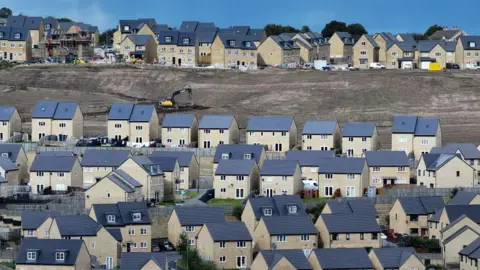 Getty ImagesIn an average working day, Claudia Bowring has to play the role of detective, estate agent, family mediator and, occasionally, grief counsellor.
Getty ImagesIn an average working day, Claudia Bowring has to play the role of detective, estate agent, family mediator and, occasionally, grief counsellor.
She’s an empty homes officer for a borough council in the suburbs of Nottingham.
There are just short of 700,000 empty and unfurnished homes in England, according to the most recent government figures. Of those, 261,471 are classed as “long-term empty,” meaning no-one has lived there for six months or more.
If all empty homes were brought back into use, the housing crisis would be solved at a stroke and, arguably, the government would not have to build 1.5m new homes.
Unfortunately, it’s not as simple as that. Bringing derelict and abandoned properties back to life can be a long and complex process.
Even finding out who owns properties that have been standing empty for years, or in some cases decades, can be a challenge.
Ms Bowring regularly uses a genealogist to track down the owners of long-abandoned houses on her patch in Rushcliffe.
They are not always happy to be reminded of their responsibilities.
“In some cases, people don’t really understand the seriousness of their property being empty,” she says.
“They think ‘well, it’s my house, there is nothing the council can say or do to make me change my mind.’”
Often homes become empty when the owners pass away, leading to a long administrative process known as probate, when their assets are divided up.
Once that has been settled, families can still be reluctant to part with a property. Claudia Bowring is facing this problem with one of the houses on her patch.
“The children have grown up there, their mum’s died and left them the house, and emotionally they feel quite attached to the property, and me suggesting they should get rid of it or have it for rental is quite difficult to hear.
“They don’t want to see someone else living in the property. They’ve got trees that they planted in the garden when they were children, and they don’t want someone coming in and ripping those up.”
When persuasion fails, the gloves come off.
Why are we building homes when so many are standing empty-
Related Posts
Why did the -trilogy- of red performing arts in Yinan, Shandong become so popular-
On October 15, a vibrant scene unfolded in Changshanzhuang Village, located in the Ma Muchi Township o
Follow the general secretary’s inspection footsteps|Look at Xiamen
**Interviewer:** Can you tell us about Xiamen and its significance?**Interviewee:** Xiamen, historically know
